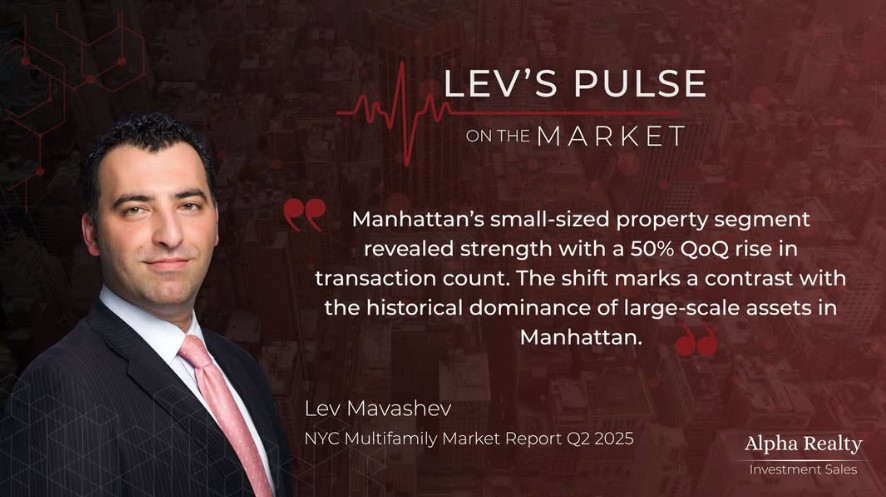By Lev Mavashev, Principal, Alpha Realty
The first half of 2025 has given us something we haven’t seen in a while in New York City multifamily: momentum. After two years of uncertainty, deal velocity is back, capital is flowing across all boroughs, and buyers and sellers are finally finding common ground.
According to Alpha Realty’s Q1 and Q2 2025 reports, NYC recorded 527 multifamily transactions in the first six months of the year, up more than 36% year-over-year. Dollar volume held steady at just over $3 billion, underscoring that investors are transacting again—even if they’re favoring smaller, more tactical acquisitions.

Manhattan: Cooling After a Strong Start
In Q1, Manhattan looked like it was regaining its swagger. Average deal size more than doubled year-over-year to $13.5 million, as large-scale trades dominated activity. But by Q2, momentum cooled. While the borough still recorded 56 deals, total dollar volume fell more than 40% quarter-over-quarter as big-ticket transactions dried up. Interestingly, buildings with fewer than 10 units posted a 50% increase in deal count, showing that investors still want Manhattan exposure—just at a more manageable scale.
Brooklyn: The Borough of Consistency
Brooklyn continues to be one of the most resilient submarkets in the city. In Q1, the borough posted $514 million in trades, and by Q2, it notched 129 transactions—up nearly 100% from the same time last year. The majority of activity came from small and mid-sized properties, which appeal to both private capital and institutional players looking to diversify.
Rents in Brooklyn remain among the highest in the country, averaging close to $4,000 a month. With international capital now expanding beyond Williamsburg and Downtown into neighborhoods like Flatbush and Bay Ridge, Brooklyn is proving to be NYC’s most dynamic submarket.
Queens: Fewer Deals, Bigger Prices
Queens entered 2025 with strong momentum. Q1 saw a 106% year-over-year jump in dollar volume, but by Q2, deal flow slowed with just 38 trades. At the same time, pricing climbed. Larger assets drove much of that growth, with average deal sizes surpassing $5 million. Queens continues to attract investors looking for scale at a discount to Manhattan, particularly in transit-oriented hubs like Jamaica, Jackson Heights, and Astoria.
The Bronx: The Breakout Story
If there’s one borough that deserves the spotlight in the first half of 2025, it’s the Bronx. Q1 showed steady activity, but Q2 was a breakout quarter. The Bronx recorded 74 transactions—up 139% from Q1 and nearly triple last year’s figure. Total dollar volume surged to $401 million, a 314% jump quarter-over-quarter, driven by strong investor demand for buildings with more than 20 units.
For years, the Bronx was considered the tertiary market of New York City. Not anymore. Value-add investors are circling aggressively, drawn to relative affordability and scale. With rents holding firm and supply constrained, the Bronx has quickly become one of the most compelling submarkets in the city.

What the Data Tells Us
The numbers paint a clear picture:
- Velocity is back. Transactions are rising across all boroughs, even if the average deal size is shrinking.
- The Bronx is commanding investor attention. Its growth in both volume and dollar activity is unparalleled this year.
- Brooklyn is the borough of choice for consistency and long-term growth.
- Manhattan remains liquid, but deal flow has shifted. Instead of trophy assets, smaller, more tactical deals are driving activity.
Beyond the transaction data, the fundamentals are supportive. While rents nationwide have cooled, New York continues to buck the trend. Both Manhattan and Brooklyn set new rent records this year, and Queens and the Bronx are not far behind. That rental resilience is fueling investor confidence and bringing foreign capital back into the market.
The Outlook
The first half of 2025 confirms what many of us in the market have been sensing for months: the NYC multifamily sector has turned the corner. Momentum is building, and sidelined capital is re-entering the market. Optimism around interest rate cuts, coupled with renewed international demand, will likely push transaction velocity even higher in the second half of the year.
For sellers, this is the moment to position assets strategically. Buyers are active again, and liquidity is improving. For buyers, opportunities remain—particularly in the Bronx and Queens—but the window for discounted acquisitions is starting to close as competition increases.
Bottom line: NYC multifamily has its stride back. Momentum is here, and smart money is moving quickly to capture it.

